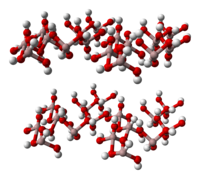
Photo from wikipedia
This paper investigates the effect of aluminum hydroxide (ATH) content on the free volume and surface recovery property of polydimethylsiloxane (PDMS)–based silicone rubber containing low-molecular-weight siloxanes. With increasing ratio of… Click to show full abstract
This paper investigates the effect of aluminum hydroxide (ATH) content on the free volume and surface recovery property of polydimethylsiloxane (PDMS)–based silicone rubber containing low-molecular-weight siloxanes. With increasing ratio of ATH up to 43.1 wt %, the concentration of cyclic siloxanes (Dn = [(CH3)2SiO]n, n = 4–12) in the PDMS matrix increases remarkably, indicative of a spacing effect of ATH particles on the crosslinking of PDMS chains. When more ATH is added, the concentration of D4–D12 began to decrease. PDMS network variation is verified by free volume size corresponding to τ3 in positron annihilation lifetime spectroscopy. The o-Ps intensity decreases linearly with ATH content. Data obtained from X-ray photoelectron spectroscopy suggest the surface recovery property is weakened by ATH. This process is dominated by the amount of free volume holes in the sample. © 2017 Wiley Periodicals, Inc. J. Appl. Polym. Sci. 2018, 135, 45803.
Journal Title: Journal of Applied Polymer Science
Year Published: 2018
Link to full text (if available)
Share on Social Media: Sign Up to like & get
recommendations!